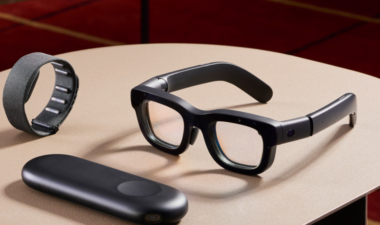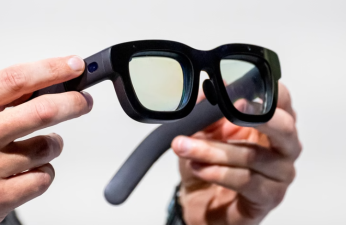Although AI smart glasses products have not yet been widely popularized, the global AI smart glasses track is rising strongly, and there are undercurrents at the B-side enterprise level. Technology giants are increasing their investment and cutting-edge companies are rushing to enter the market, all of which are "betting" on this product of the future in order to seize the market window period.
When it comes to AI smart glasses, Meta is indispensable. It has created a hit AI smart glasses product, Ray Ban Meta, which has sold millions of units, and market demand is still increasing. At present, Meta seems to be preparing for the development of new products in full swing to continuously expand its leading advantage.
Although AI smart glasses products have not yet been widely popularized, the global AI smart glasses track is rising strongly, and there are undercurrents at the B-side enterprise level. Technology giants are increasing their investment and cutting-edge companies are rushing to enter the market, all of which are "betting" on this product of the future in order to seize the market window period.
When it comes to AI smart glasses, Meta is indispensable. It has created a hit AI smart glasses product, Ray Ban Meta, which has sold millions of units, and market demand is still increasing. At present, Meta seems to be preparing for the development of new products in full swing to continuously expand its leading advantage.
Technical highlights of Aria Gen 2
Although Aria Gen 2 is currently limited to researchers and has not directly entered the consumer market, this does not prevent us from getting a glimpse of Meta's profound ideas and technical accumulation for AI glasses. In fact, this pair of glasses has already shown some forward-looking design elements of the next generation of Ray-Ban Meta. Aria Gen 2 showcases cutting-edge technology, with multi-function sensors, advanced perception capabilities, and efficient AI processing capabilities, and is a benchmark for the development of smart glasses.
Meta Aria Gen 2 is not alone. Its predecessor was unveiled in 2020, aiming to help researchers accelerate the transformation of machine perception and artificial intelligence technology with the help of cutting-edge hardware, open source data sets and model tools. Five years later, Aria Gen 2 has been completely renewed. Not only has it achieved an all-round improvement in performance, but it also hides a carnival of technology under its "simple" appearance.
Appearance
Aria Gen 2 retains the rugged style of the prototype, but its progress is obvious compared to the first generation. The front frame is designed like ordinary glasses, and its lightweight weight is only 75 grams. Although the temples are still wide, this does not prevent it from integrating many high-tech sensors. Specifically, Aria Gen 2 has built-in RGB cameras, 6DoF SLAM (spatial positioning) cameras, eye tracking cameras and other cameras, as well as spatial microphones, IMUs (dual inertial measurement units), barometers, magnetometers and GNSS (satellite positioning) sensors. In addition, Meta has cleverly embedded a PPG sensor and a contact microphone in the inconspicuous position of the nose pad, which are used for heart rate measurement and precise sound pickup respectively.
This design idea, which is almost "stacking" at the perception level, is Meta's in-depth exploration of the future form of smart glasses. Perception is not limited to collecting data, but through structured language models and end-to-end learning to deeply understand the spatial environment of the real world, so as to achieve accurate and efficient perception of the world. Aria Gen 2 not only supports gesture tracking, but also comes with AI personal assistant Ally to simplify human-computer interaction and provide open interfaces for researchers to test various interactions and AI algorithms on the glasses.
It is worth mentioning that although Aria Gen 2 has made drastic improvements in hardware and weighs only 75 grams, it has achieved a significant improvement in battery life. Although Aria Gen 2 is light, it has excellent battery life performance thanks to customized chips and optimized power management. Officials claim that it can be used continuously for up to 6 to 8 hours. This excellent battery life performance is undoubtedly due to more efficient customized chips and careful power management design.
Technology blueprint and chip innovation
Observing the technical architecture of Aria Gen 2, it is not difficult to get a glimpse of the technical blueprint of the next-generation Ray-Ban Meta glasses. The next-gen Ray-Ban Meta may use Meta's customized chip to enhance local AI computing capabilities and achieve a better user experience. It is reported that Ray-Ban Meta will use the Snapdragon AR1 Gen 1 platform, which is not only equipped with a high-performance CPU, but also integrates computing units such as ISP, NPU, and GPU, so that functions such as voice interaction, image recording, and image presentation can be realized.
But to make AI glasses achieve greater breakthroughs, existing technology alone is far from enough, and the balance between power consumption and performance must be solved. It is worth noting that Aria Gen 2 is equipped with Meta's customized low-power AI chip, which shows that Meta is trying to get rid of its dependence on third-party chips and lay the foundation for future consumer products. This means that the next-generation Ray-Ban Meta may use Meta's customized AI chip to enhance local AI computing capabilities.
Future trends of AI glasses
From the current development trend, these functional combinations are expected to become the standard configuration of the next-generation Ray-Ban Meta. With the breakthrough of display technology, the AI glasses market has great potential, and the combination of AI and display functions is expected to become mainstream. Although Aria Gen 2 is not equipped with an optical display module, this has not prevented breakthroughs in display technology for consumer glasses. According to a report by the Financial Times at the end of last year, Meta plans to introduce a display screen for Ray-Ban Meta smart glasses in 2025.
At the same time, judging from the product positioning of Ray-Ban Meta and its competitive situation with Essilor Luxottica, the next generation of products may still retain a non-display version. In terms of appearance design, it is expected to continue the classic Ray-Ban style of the first two generations of products.
With the continued prosperity of the AI glasses market, major manufacturers are exploring the road to innovation. Although the current market structure is not yet completely clear, it is foreseeable that those products that can first introduce advanced display technology and continuously improve user experience will be more likely to stand out in the fierce market competition. The emergence of innovative products such as Rokid Glasses is a strong proof of this trend.



